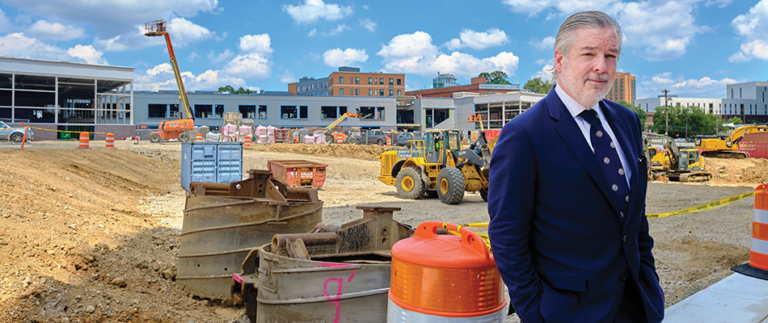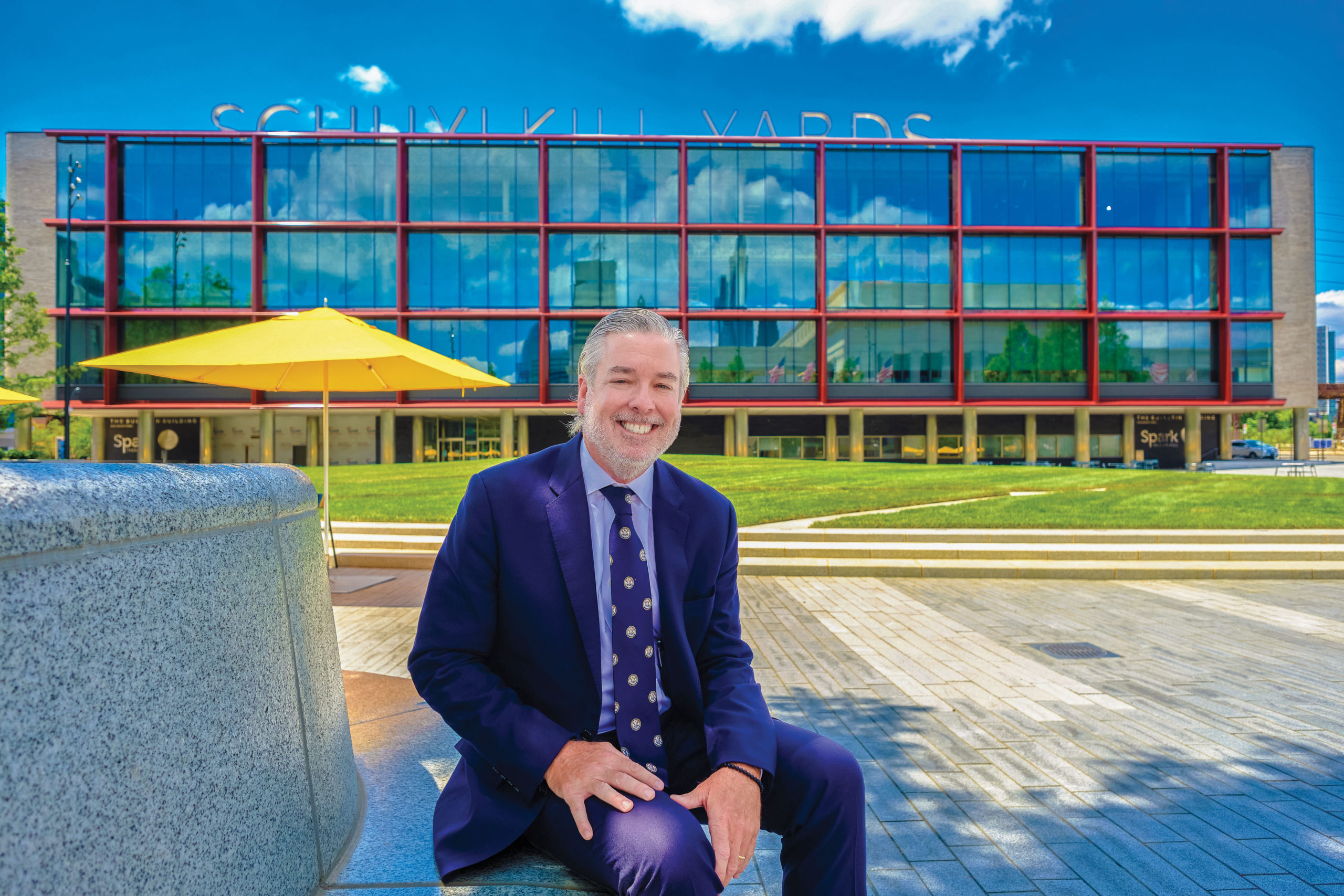
President John Fry takes in the new Drexel Square park outside the renovated Bulletin Building at 3025 Market Street.
Here, at 30th and Market streets, a grassy new city park has opened adjacent to Amtrak’s bustling 30th Street Station. Graceful, 30-foot dawn redwoods in huge concrete planters ring the 1.3 acres, and at its center, a striking elliptical hillock rises, its lawn crisscrossed with granite pathways and bordered by café tables with yellow umbrellas.
This is Drexel Square. Before, this space was an asphalt parking lot alongside an unadorned office building. Its transformation is the preamble to a swath of development that will ring the square with landscaped streets and modern high rises to house a new life sciences and tech innovation district that will change West Philadelphia.
On this sweltering July afternoon, a suited President John Fry with a snug blue tie lingers in a spot of shade. As he savors this first fruit of a master plan 10 years in the making, Fry unspools a far-reaching vision, one that’s research-centric, but also civically engaged, for what’s to come here and beyond — all built on what he calls “really sweet deals.”
“We get to curate what we need,” Fry says, “but use other people’s financial capital to achieve our goals.”
For instance, Drexel needed a childcare center.
It needed more beds for its swelling student population.
It needed accommodations for visitors and parents.
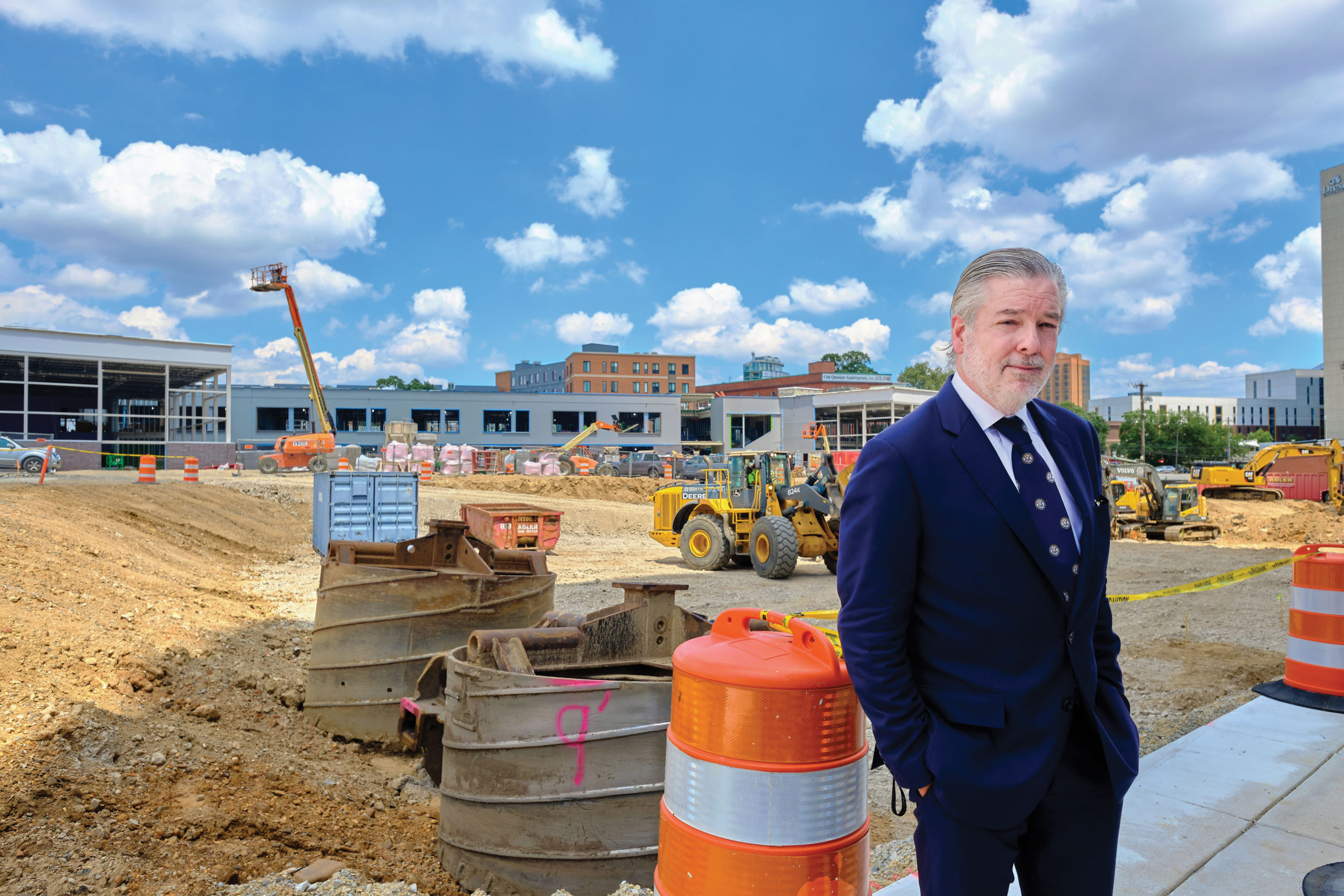
President John Fry, on the uCity Square site where a Drexel partner is constructing a new building in which to relocate two public schools that serve 800 K-8 students in West Philadelphia.
Drexel didn’t have the financial depth for such projects, but it snared all three and then some through public-private partnerships with independent developers: a childcare facility inside Radnor Property Group’s Vue32, a hotel with Hospitality 3’s The Study at University City, and student housing with American Campus Communities’ Chestnut Square, University Crossings and Summit. Most include street-level retail, restaurants and services.
Put simply, third-party developers erect, at their own expense, buildings on Drexel-owned land, for which Drexel collects ground rents as well as options to occupy space on favorable terms for classrooms, labs and faculty offices. At the end of the leases, which range from 50 to 99 years, ownership of the buildings reverts to Drexel.
The University has always taken the long view with its land acquisition and is now capitalizing on past investments. Third-party developments monetize the land, resulting in cash and appreciated assets that diversify Drexel’s endowment portfolio and enhance its balance sheet. Current annual ground leases with American Campus Communities, Radnor Property Group and Hospitality 3 generate $1.3 million annually to support University operations. Over the full term of these long-term leases the University is projected to receive over $60 million.
Best of all, the projects free up Drexel to focus its own expenditures on academic investments: classrooms, laboratories and endowed chairs.
“If you do it well, public-private partnerships are a win-win for the developer, the University and the end users within the University — and the community benefits,” says Donald E. Moore, who was Drexel’s vice president for real estate and facilities from 2018 to October 2020.
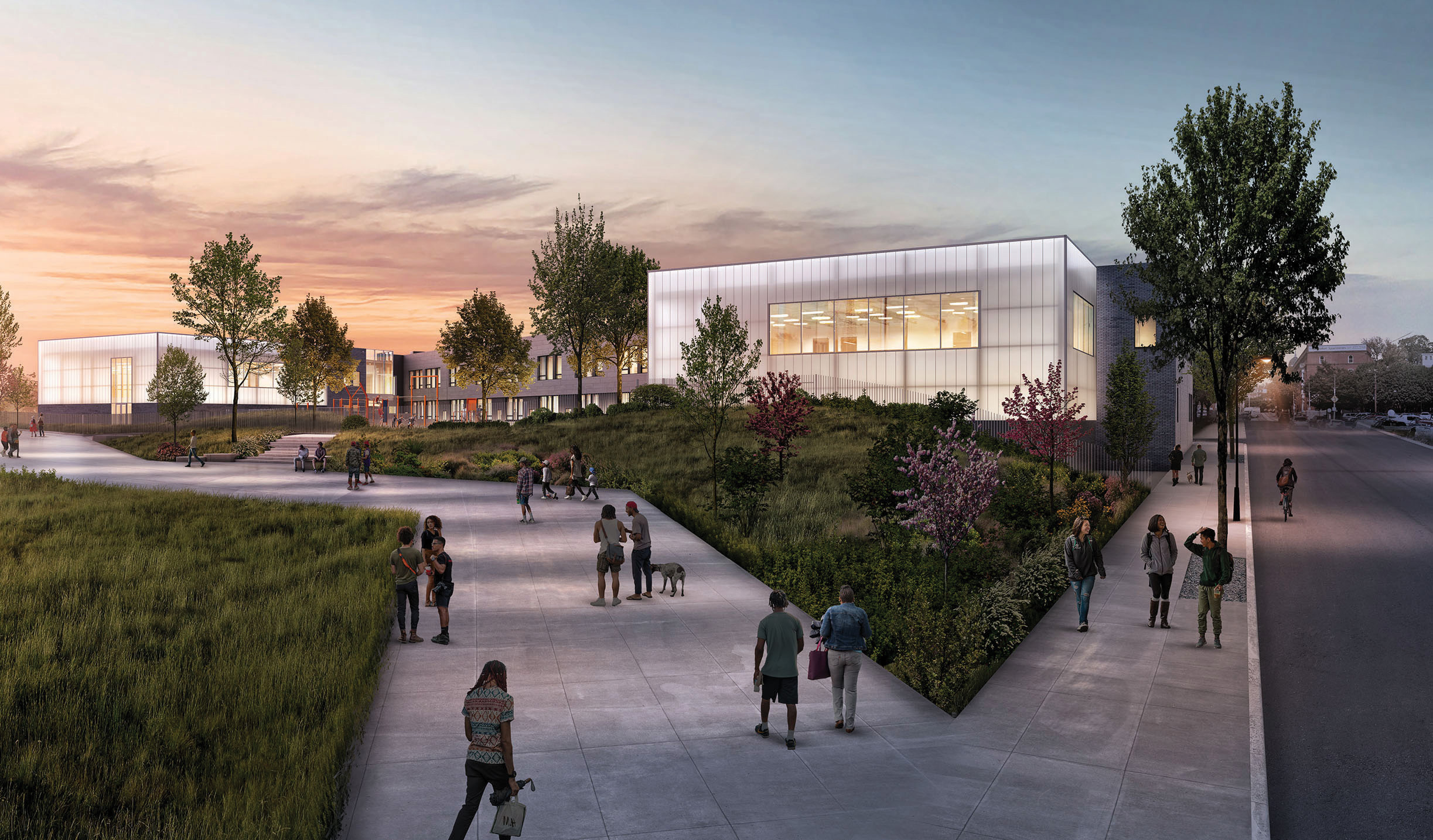
Construction on the Powel/SLA-MS public school building paused during the lockdowns but the project is now expected to be complete in time for spring 2021 occupancy.
Civic Anchor
Over his long career, Fry has always had an urban planner’s eye. As chief operating officer at the University of Pennsylvania, his pioneering use of public-private partnerships at the Ivy unleashed a wave of revitalization in West Philadelphia. Fry continued that charge as president of Franklin & Marshall College, where he brought together partners for the $75 million Northwest Gateway reclamation project — one of the largest in the history of Lancaster, Pennsylvania.
“It’s a way to secure the future,” says Harris Steinberg, executive director of the Lindy Institute for Urban Innovation, a Drexel think tank. “John took the lessons he learned from his Penn days and walked purposefully into the role of being a civic leader, an anchor institution. He brought it to Drexel with vision.”
From the get-go, Fry understood the power of unlocking Drexel’s prime location to expand campus life without draining Drexel’s financial resources, in a way that also creates jobs and resources for the low-income neighborhoods to Drexel’s north.
“John Fry was one of the very first to realize that universities had an obligation to tear down the walls and barriers that separate them from their communities and become a true partner in the community development of their neighborhoods,” says Richard Florida, an urban studies theorist at the University of Toronto.
Last year, while a Philadelphia Fellow with the Lindy Institute for Urban Innovation, Florida noted that Drexel — with its University-wide diversity policies for local hiring, procurement and construction contracts — has moved the needle by “rethinking its institutional boundaries, including finding new ways to make the campus physically more inviting to neighbors.”
Drexel Square is one of those ways, but it’s just the beginning of something vastly larger. The $14.3 million makeover is phase one of Schuylkill Yards, a massive $3.5 billion district of purposefully designed mixed-use buildings and streetscapes that Philadelphia-based developer Brandywine Realty Trust will construct across 14 acres of Drexel land over the next 20 years.

The future home of Samuel Powel Elementary and the Science Leadership Academy Middle School is being built on on Drexel-owned land that the University leases to the School District of Philadelphia for a nominal fee.
With palpable excitement, Fry explains why the park is a point of pride. “The single most valuable piece of real estate in Schuylkill Yards is this — the square,” he says. “Any sensible person would have put up a 50-story building right here. Inclusion is symbolized by the fact we didn’t. We put a park.”
The square is the first thing one sees when arriving in Philadelphia from an Amtrak train, and it serves as a gateway to the campus and to the future Schuylkill Yards district. It will put out a welcome mat to the larger community with yoga classes, art exhibits, concerts and more, forming an epicenter for social engagement (well, post COVID-19 at least). It also acts as a bold statement piece — a sign of Fry’s commitment to the civic health of the larger community that he has embraced from his first days at Drexel.
“We wanted to make the point that because it’s the most valuable space,” he says, “it should be here for the public.”
With Drexel Square complete, Brandywine is turning toward JFK Boulevard, on the square’s north side, where two modern high-rises will fill what is currently a sea of asphalt. The structures will house nearly 1 million square feet of apartments, offices, labs and shops. JFK’s faceless lanes will be made over into a tree-lined, pedestrian-friendly thoroughfare finally worthy of the name “boulevard.” Undeterred by the pandemic, Brandywine is also accelerating development of a nearby parcel at 32nd and Market streets, to enhance “flow” between the towers and Drexel’s campus.
“The biggest challenge in the university space is how to allocate resources,” says Jerry Sweeney, president and CEO of Brandywine. “We’ve found that universities that think broadly create the most value over the shortest period of time at the most optimal return level.” Schuylkill Yards, by way of Brandywine’s upfront, long-term ground lease, has monetized $80 million of land assets held in Drexel’s endowment, which totaled $811.3 million at the end of fiscal 2020.
“You begin with simple geography,” Fry says of his vision.
University City, sprawling on the west bank of the Schuylkill River, is the true “center of the city,” he and others contend, given its proximity to the train station and cutting-edge “eds and meds” institutions. Add in smart real estate buys by Drexel over the years, including in 2011 the parking lot that is now Drexel Square, and “it didn’t take a genius to figure out that what we need to do is begin to think about those big parcels and how we begin to stimulate meaningful, mixed-use, neighborhood-friendly development,” Fry says.
By the Numbers
Ground lease income contributed to the University’s operations from development of Chestnut Square, The Study, The Summit and Vue32.
Value of land assets converted to cash in Drexel’s endowment through the first phase of the development of Schuylkill Yards.
Approximate increase in the value of the University’s asset balance sheet as a result of the acquisition of the former University City High School site at UCity Square (though some parcels were since sold to Wexford as part of the development agreement).
Growth Through Innovation
At the time of Drexel’s founding in 1891, this area was a busy industrial district filled with factories, ironworks and slaughterhouses. Anthony J. Drexel chose to build his school close to the workers who roamed this region, to provide them with access and advancement, regardless of race, sex or creed.
“That was not an accident,” says Fry. “He thought deeply about that.”

Chestnut Square | Drexel’s first third-party partnership was in 2012, with Austin, Texas-based American Campus Communities (ACC). ACC spent $100 million to transform Chestnut Street between 32nd and 33rd streets into a lively block that boasts 361,200 square feet of mixed-used student housing (860 beds) and retail space. ACC developed the space and manages it, while providing annual ground-rent payments to Drexel under a 70-year ground lease.
Nonetheless, for most of the 20th century Drexel has fallen short of the founder’s dream.
Forty-five percent of residents in the 19104 ZIP code, which includes Drexel and Penn, live below the poverty line — more than double the Philadelphia metro area’s rate, the Census finds. In his first Convocation speech in 2010, Fry imagined how A.J. Drexel would feel if he strolled through parts of West Philadelphia today.
“I think he would have felt, ‘Boy, my institution could have done a lot more but didn’t,’” Fry says. “I tried to call the community on that.”
Once Drexel chose Brandywine as its projects master developer, Brandywine introduced a $16.4 million neighborhood engagement initiative as part of Schuylkill Yards. The program is considered the largest of its kind in Philadelphia, and addresses community needs including small, local and minority business development; job creation; affordable housing; capacity building; and educational support. One highlight: About 50 new minority apprentices are either working in the construction trades or on the way to those living-wage jobs, according to Sweeney.
“The objective was to create a true neighborhood, not a collection of buildings, and to have one of the driving predicates of that neighborhood be how we tap into the innovation economy,” Sweeney says.
As part of the Drexel Square renovation, Brandywine undertook a $43 million rehab of the 1954 George Howe-designed modernist Bulletin Building (acquired by Drexel in the ’90s) on the square’s western flank. Now refaced with contemporary glass and 10,000 square feet of street-level retail, it is occupied by Spark Therapeutics, a gene-therapy biotech with a path-breaking treatment for an inherited retinal disorder. Last year, Switzerland’s Roche Holding acquired Spark for $4.3 billion, a stunning return.
The startup was founded as a result of technology and know-how accumulated at Children’s Hospital of Philadelphia. It has grown to 500 employees and plans to hire 100 more this year in spite of the pandemic.
Fry sees Spark’s success as emblematic of how Drexel land development can unite academic researchers, student co-ops and local workers around an innovation economy.
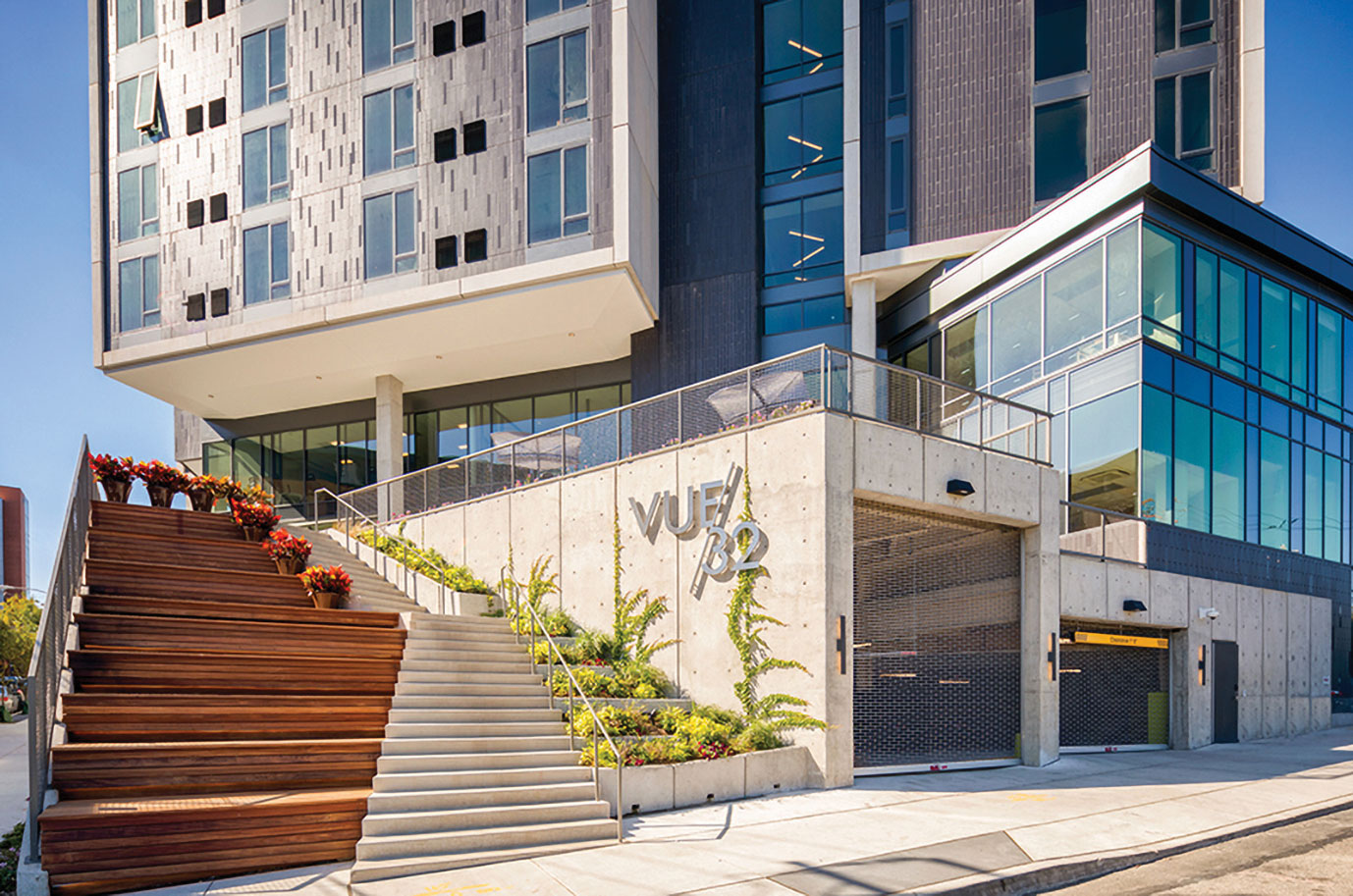
Vue32 | The $72 million, 16-story Vue32 tower was built at 3201 Race Street by Wayne, Pennsylvania-based Radnor Property Group in 2017. It houses a large daycare, sorely needed by Drexel working parents, and 164 apartments. Adjacent to it is the Summer12 market-rate townhomes (including one owned by Drexel for visiting VIPs). The project was named Deal of the Year in 2017 by the Philadelphia Business Journal.
“Innovation is symbolized by Spark,” Fry says, looking toward the downtown skyline reflected in the Bulletin Buildings’ façade of windows. “It is a company with incredible potential for growth and development to change the economy of Philadelphia.”
For Spark CEO and co-founder Jeff Marrazzo, the company’s expansion in the Bulletin Building offered an opportunity beyond the bottom line: Create a bio-tech ecosystem that supports jobs of the future in West Philadelphia. “I personally wanted to make a bit of statement,” he says.
He calls the national dialogue around social justice an inflection point. “We can accelerate a lot of that work,” he says. “This foundational decision, where we located, set us up to be able to have that impact. Now, we have to do it more consciously, more aggressively and with more directed programming.”
He’s on board with Fry’s vision, which includes developing a training program for community residents to prepare them for Spark’s hiring needs in research, of course, but also in manufacturing, finance, human relations, communications and strategy. The company already participates in the Chamber of Commerce for Greater Philadelphia’s Future Ready program that brings middle school students to Spark for an immersive day exploring gene therapy career options. And Marrazzo looks forward to the “natural connections” with Drexel faculty that come with being a block away, as well as continued hires of co-op students and new graduates.
Around the corner, at 3101 Market Street, is another marker of Drexel’s growing innovation district: The Center for Functional Fabrics, led by fashion designer turned tech innovator Geneviève Dion, professor of design in the Westphal College of Media Arts & Design.
In fall 2019, state and federal government officials celebrated the opening of the Pennsylvania Fabric Discovery Center inside Dion’s new lab, surrounded by advanced machinery for prototyping tomorrow’s textile inventions: a 3D body scanner, an ultrasonic sewing machine, and textile testing machines.
Funded by the Department of Defense and the Commonwealth, the venture aims to restore Pennsylvania’s standing as an American textile manufacturing hotspot.
“By marrying design to technology, Professor Dion has the means to rebuild Pennsylvania’s textile manufacturing industry, this time with an unassailable competitive advantage,” says Richard A. Greenawalt ’66, chair of Drexel’s Board of Trustees. “I’m proud that her discoveries will seed new industries, and that Drexel had the imagination to back her years ago.”
“It’s not just the place,” Dion says. “Schuylkill Yards is a philosophy about what can be the future.”
‘Cradle to Career’
Meanwhile, six blocks to the west, rising like a twin bookend to Schuylkill Yards, is the $1 billion uCity Square development.
The construction site at 36th and Warren streets will house a $40 million building for two public schools serving 800 students in grades K-8. It is being developed by Baltimore-based Wexford Science & Technology, another of Drexel’s third-party partners. Drexel staff spent six years raising funds to pay for the project — an investment of manpower that ensured the construction of a new school for the neighborhood at no direct cost to Drexel.
Here is where Fry envisions a route for West Philadelphia residents and their children to enter the innovation hub Drexel is building at Schuylkill Yards.

The Study | Several years ago, Fry invited Hospitality 3 to duplicate its sophisticated but comfortable The Study at Yale, where he happened to stay while in New Haven. Opened in 2016 at a price tag of about $50 million, The Study at University City at 33rd and Chestnut streets provides 212 rooms, 7,000 square feet of banquet and meeting space and a 105-seat restaurant and bar — a welcome abode for visitors to campus.
As Fry walks past the uCity Square construction site, where the two-story frame of the school is underway, an excavator beeps and hums over a gravel patch.
“Take a look all around you,” Fry says. “This is going to be amazing.”
In 2014, Drexel University City Development, a joint venture between the University and Wexford, purchased a 14-acre site from the School District of Philadelphia that held the former University City High School, thereby expanding the uCity Square footprint that Wexford already was developing along Market Street.
The complex deal was no sure-fire proposition. Drexel’s hope to build a facility to accommodate the overcrowded Samuel Powel Elementary School and the new Science Leadership Academy Middle School, or SLA-MS, required a careful piecing together of public, private and foundation dollars to pay for construction once the land was acquired, in itself a feat. The School District of Philadelphia will operate the schools and lease the facility from Drexel for a nominal fee.
“It took five or six years to have a creative mechanism to pull it off,” says Moore of the financing. “It took thinking outside of the box. It was one of the more robust discussions I had with the Board of Trustees over a deal.”
Drexel’s persistence paid off. Here, after all, was a chance to create transformational change through what Lucy Kerman, senior vice provost for university and community partnerships, calls a “cradle-to-career” ecosystem.
“We are a University that sees ourselves as deeply engaged in the life of our city and focused on solutions,” she says. “If we educate local children in a location that is in the heart of the innovation economy, these children will be exposed to jobs of the future.”
The dream is that a child born into poverty nearby could achieve prosperity in a generation with a degree and a well-paying job. Drexel also partners with training groups such as the West Philadelphia Skills Initiative to help unemployed adults get jobs on its campus, and its popular Dornsife Center for Neighborhood Partnerships provides an array of resources to West Philadelphia residents.
“We’re in this in a wrap-around way,” Kerman says, “to ensure inclusion of local residents.”
Once again, Drexel’s success has depended on its partner. In Wexford, it found common ground. Executive vice president Joe Reagan says the uCity Square development not only advances the economic development of West Philadelphia but also Wexford’s community-oriented focus through the collaboration with Drexel on Powel and SLA-MS.
“To me it was the perfect alignment,” he says.
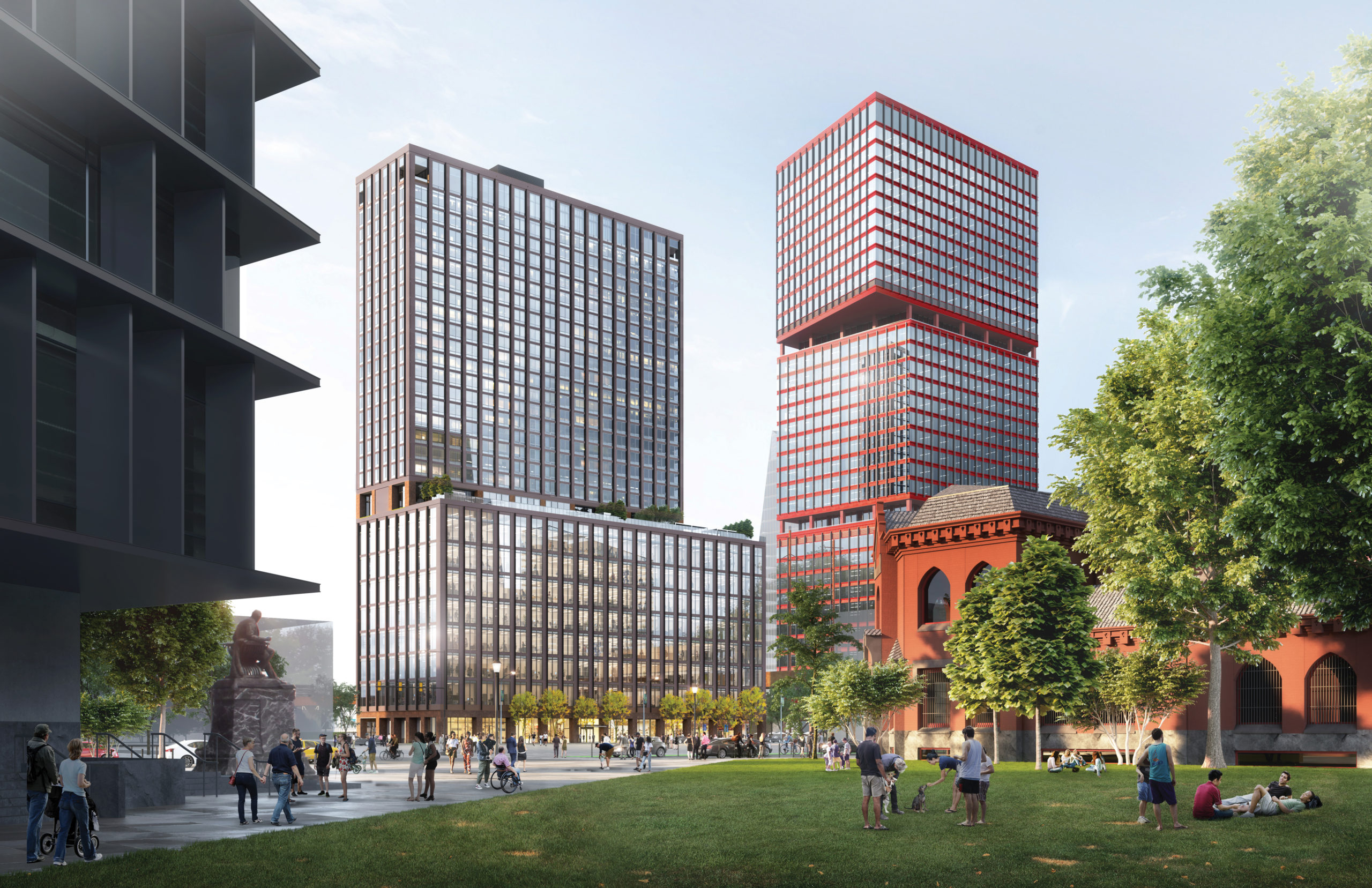
JFK Towers | This year, Brandywine Realty Trust will begin construction on two towers flanking Drexel Square. The tower at 3025 John F. Kennedy Blvd. will have 200,000 square feet of offices and 326 apartment units. The other, at 3001 John F. Kennedy Blvd., will comprise 775,000 square feet of offices. Later phases of the Schuylkill Yards master plan will eventually build out a total of 14 acres throughout Drexel’s campus over a period of 20 years.
Like Schuylkill Yards, this section of campus will meld life sciences, tech, education and entrepreneurship. On a parcel next to Powel and SLA-MS, Wexford is building a multi-story academic tower that will house the College of Nursing and Health Professions and parts of the College of Medicine, which are currently renting space in other parts of the city. The University City Science Center incubator is a neighbor. And last year, Drexel’s College of Computing & Informatics moved into 3675 Market Street, a Wexford-owned building across from the uCity site, uniting for the first time its faculty under one roof in state-of-the-art facilities.
“The exciting key factor is location,” says Dean and Isaac L. Auerbach Professor Yi Deng. “That creates a very conducive ecosystem to drive our core missions of talent and research development and industry partnership.” Besides collaboration with startups, he expects joint programs with the schools and with nursing and medicine.
Likewise, Laura N. Gitlin, dean of the College of Nursing and Health Professions, anticipates that the college’s move from Center City to uCity in 2022 will expand simulation labs, where nursing students practice disaster scenarios in reenactments with locally hired actors. “We need more space to expand,” she says, “and also to provide better and higher state-of-the-science laboratories.”
Drexel is commencing this forward-looking transformation of West Philadelphia with eyes wide open to past errors, when public-private partnerships displaced communities in the name of “urban renewal.”
In the ’50s, federal housing legislation made it attractive for cities to use eminent domain to acquire land for redevelopment. Around the country, private universities in need of expansion space worked with city agencies to demolish aging neighborhoods around their campuses. Section 112 of the Housing Act of 1949 subsidized these clearances with federal money and permitted liberal interpretations of what constitutes “blight.” At Vanderbilt University, for example, Nashville condemned a middle-class neighborhood of largely white professionals and retirees despite the vast majority of homes being in acceptable condition.
In Philadelphia, the city condemned large sections of West Philadelphia, including Black Bottom, a neighborhood that stretched from 32nd Street to 40th Street and from University Avenue to Lancaster Avenue. Eminent domain spelled the end for a community of predominantly working-class African Americans, renters and small businesses.
In its place, a consortium of “eds and meds” institutions led by the University of Pennsylvania erected the University City Science Center, superblocks for Penn dorms, and parking lots. One parcel was allocated to Drexel, which later built dormitories abutting the residences of Powelton Village.
“If you go to any parking lot in this part of town and you tear it up,” Kerman says, “you’ll see bricks; you’ll see the bones of these neighborhoods.”
Conflict spawned during that era influences relationships between West Philadelphia institutions and its neighbors to this day, and Drexel is determined that in future development, the community be involved.
This is why Drexel insists that hiring and procuring contracts for these projects include the local economy. With a sensitivity to the history of the site, Drexel and its partners are committed to returning some of the old street grid — 37th, Cuthbert, Warren streets — to the development plans. And even when financing seemed like an impossible hurdle, Drexel steadfastly pursued the means to build a public school on the site, as a replacement for the University City High School that closed in 2013.
Drexel’s ongoing conversations and regular engagement with the Powelton Village Civic Association and local homeowners is why, in gaining approvals for the Summit Tower, Drexel guaranteed Powelton Village residents that it would require all sophomores, in addition to freshmen, to live on campus — a step administrators hope will assuage the kind of town-and-gown frictions that boiled over in the ’70s.
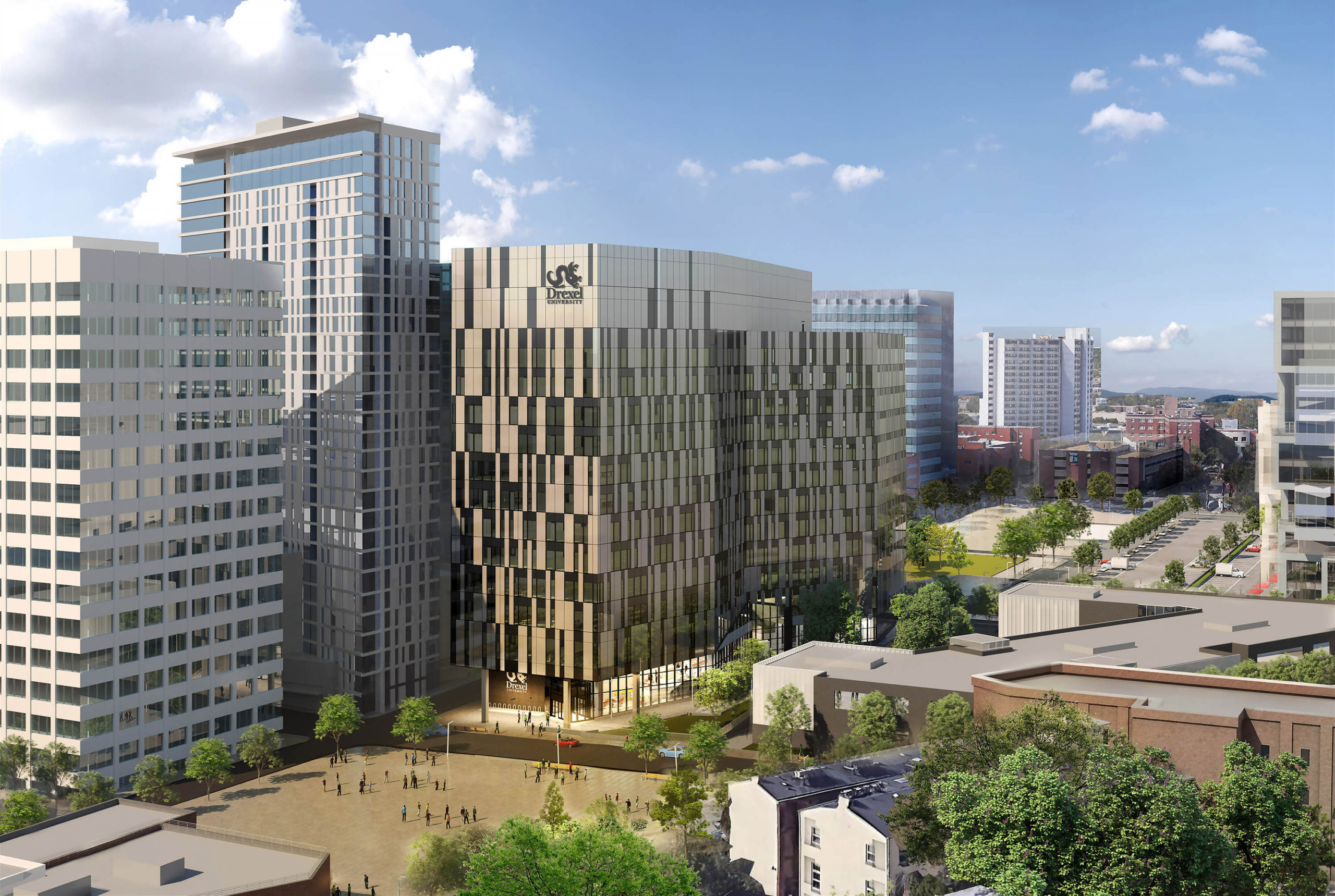
uCity | Despite a temporary slowdown at the start of the pandemic, construction has resumed at the uCity Square site. Wexford Science & Technology is building, at its own cost, new K-8 classrooms at 36th and Filbert streets. When complete, the 87,000-square-foot, two-story building will house students currently attending the Samuel Powel Elementary School and the Science Leadership Academy Middle School. Drexel secured private and public funding for the project, including generous contributions from the Lenfest Foundation, PECO, real estate investment trust Ventas, as well as New Market Tax Credits, the School District of Philadelphia, and Redevelopment Assistance Capital Program funding from the Commonwealth of Pennsylvania. The uCity Square parcel will also house a 450,000-square-foot Academic Tower where the College of Nursing and Health Professions and the College of Medicine will be co-relocated from other locations in the city. Wexford began construction on the Academic Tower in July, and aims for initial occupancy by academic year 2022–23.
“For years and years, we without ill intention grew and developed and grew and developed,” Fry says, “and it created dynamics within the neighborhood that were very negative.” As the University evolved from a commuter school to a residential one, its student population increased from 3,500 students two decades ago to 25,000 today, he says. Many of those students spill into nearby communities, leading to a market for skinny apartment buildings in the middle of residential blocks, which in turn depresses homeowner occupancy rates.
“That’s on Drexel,” he says, “because we never constructed enough beds to meet our enrollment. We’re trying to reverse some of those trends. We have worked to reset our relationship.”
As Steinberg of the Lindy Institute puts it: “It’s not just real estate deals. It’s not just opening a Starbucks on every corner. There’s a coherent and evolving strategic narrative that is really about the greater good and Drexel’s role in that…. It’s part of our moral imperative.”
Community leaders and residents are watching Drexel’s actions closely, skeptical about gentrification and the changing skyline.
“I think it’s wait and see,” says Stephen Sebelski, president of the Powelton Village Civic Association. “Schuylkill Yards and uCity Square are in such early stages.” While he expresses hope that the forthcoming school and other commercial development benefit his neighborhood, he says such projects are “always going to be a negotiation, and it’s always going to be trying to work together to do more.”
Gwen Morris, secretary of the Mantua Civic Association, also called on Drexel to find more ways “to open its arms to the community,” to invite residents onto its campus and to get community groups involved earlier in development plans.
Fry says he understands the distrust, especially among long timers who have heard the promises and seen them broken. “Ties to the community are complicated,” he says. “It always will be. I understand that people who live in the neighborhood might be saying, ‘When is this going to happen?’ It takes a while; all of this takes a while.”
In fact, Fry has a 50-year timeline for the transformation he envisions. “We’ve just done the first fifth,” he says. “There’s a long road ahead.”
In the meantime, hints of the future abound in one pocket. Look no further than the Dornsife Center, “the embodiment of what an engaged university can do,” Kerman says. The center opened in the Mantua neighborhood in 2014 offering health checks, creative writing workshops, youth dance programs, computer labs, legal clinics and more — all programs developed with Drexel faculty in response to expressed community interests, she says. At the same time, students get real-world experience and the chance to give back to West Philadelphia.
“It’s the responsible thing to do,” says Rachel Lopez, an associate professor of law at Drexel and director of the Andy and Gwen Stern Community Lawyering Clinic at the center. “[Mantua and Powelton] were here first. They really saw the university as the biggest threat to their existence.” At one early community meeting, Lopez recalls a resident saying, “The dragon is coming to get us.”
Initiatives such as the legal clinic have helped “cut through a lot of that,” she says, “and build a lot of trust. People see us as an ally.”
Angelys Torres, a 24-year-old third-year law student from Chicago, has worked with a team at Dornsife on several cases seeking expungement and pardons. “A lot of people just need to be heard and giving them an opportunity to share whatever grievance they may have and providing some type of solution makes all the difference,” she says of appreciative clinic clients. “It’s taught me a lot of compassion and empathy.” Torres plans to pursue public interest law as a result of the experience.
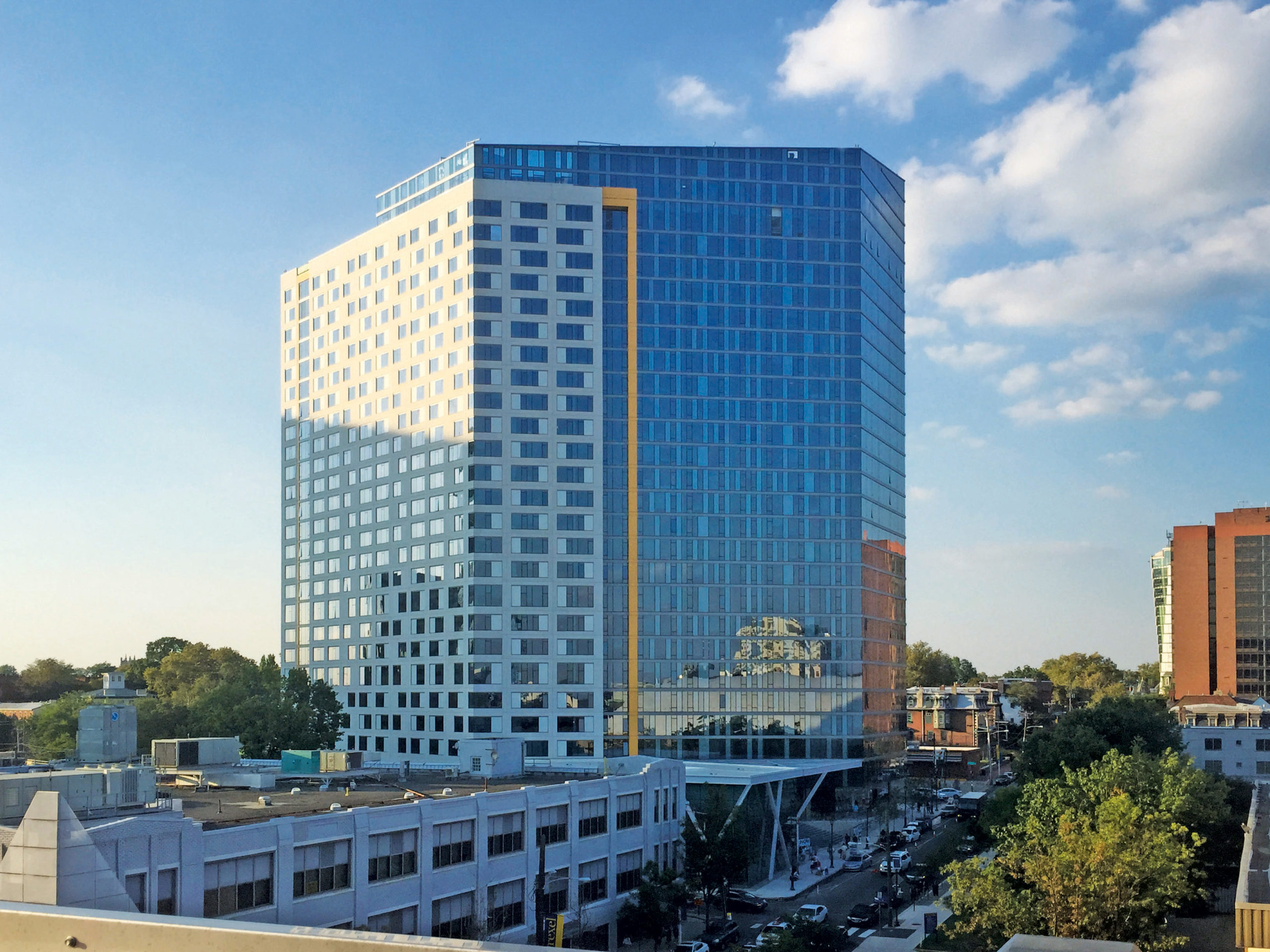
The Summit | In 2015, American Campus Communities financed and built the Summit, a gleaming, eco-friendly apartment building with street-level retail that rises 25 floors above the corner of 34th Street and Lancaster Avenue. Its 1,315 beds fulfill Drexel’s need to house students on campus where they will be less likely to disrupt nearby residential neighborhoods. Econsult estimated that its construction had a one-time economic impact to the city of about $240 million, including 850 jobs. As ACC was building Chestnut Square and the Summit, Drexel was able to focus on academic buildings: Drexel opened the URBN Center and Gerri C. LeBow Hall, renovated Stratton and Nesbitt halls and modernized several other core facilities.
Ultimately, Drexel’s task is to forge relationships, often one person at a time. That’s how Kerman spends a lot of her day. Ditto for Brian Keech, senior vice president for government and community relations.
“I have spent a career building up trust and confidence with the community,” says Keech, who came to Drexel in 1998 and regularly meets with the Powelton Village Civic Association. “This is hard work, and it takes a lot of time, energy and money to do it. But we believe in it.”
Drexel looks for similar commitment from its developer partners. When the Radnor Property Group was building Vue32, it changed the initial location because residents voiced concerns that the high-rise blocked sunlight for a community garden. In return, residents supported a taller structure.
Wexford also met regularly with civic associations, and based on community input, shifted the future school building from facing Lancaster Avenue to Warren and 36th streets, where the design fit the streetscape better. “It wasn’t ideal from our planning perspective,” Reagan allows. “But OK, we did it. We want to be part of the community.”
And so the give and take goes on.
Looking ahead, on a much longer horizon, Fry is eyeing the air rights over the Amtrak railyard. A study Drexel commissioned concludes a potential 16-million plus square feet for the having, in the mold of Manhattan’s Hudson Yards.
It would be one more investment, not only in Drexel’s future, but in West Philadelphia’s future.
“The work is never done,” he says. “It’s fair to say the promise is there, the need is there, and what we need to do is work at it.”


